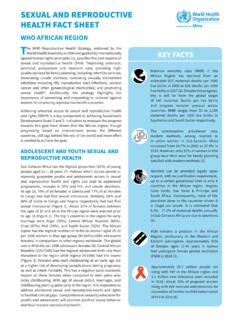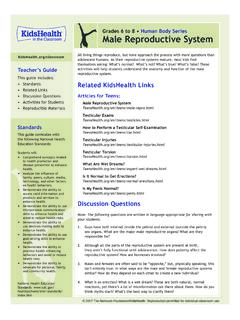Transcription of Questionnaire Design Reproductive Health Series Module 4
1 Questionnaire Design Reproductive Health Epidemiology Series Module 4 2003 Department of Health and Human Services Questionnaire Design Reproductive Health Epidemiology Series Module 4 September 2003 The United States Agency for International Development (USAID) provided funding for this project through a Participating Agency Service Agreement with CDC ( ). Reproductive Health Epidemiology Series Module 4 Questionnaire Design Jill A. McDonald, PhD Nancy Burnett, BS Victor G. Coronado, MD, MPH Renee L. Johnson, MSPH DEPARTMENT OF Health AND HUMAN SERVICES centers for disease control and prevention National center for Chronic disease prevention and Health Promotion Division of Reproductive Health Atlanta, Georgia, 2003 Contents Scope and Goals of This Chapter.. 3 Use of Questionnaires in Research .. 6 Types of Questionnaires and Modes of Administration.
2 7 Interviewer-Administered Questionnaires.. 8 Self-Administered Questionnaires .. 11 Basics of Questionnaire Design .. 12 Validity and Reliability.. 14 Borrowing Questions from Other Questionnaires .. 15 Types of Questions.. 16 Design Characteristics of Questions and Their Administration That Influence Measurement .. 20 Design Objective 1: Communicate meaning consistently.. 20 Design Objective 2: Specify how the question should be answered .. 26 Design Objective 3: Ask for something respondents are able to provide.. 27 Design Objective 4: Ask for something respondents are willing to provide.. 28 Design Objective 5: Administer questions consistently.. 30 Other Questionnaire Design Factors That Influence Data Quality.. 31 Other Standardized Text.. 31 Visual Memory Aids.. 34 Question Order .. 35 Formatting, Layout, and Related Coding Considerations.
3 37 Translation ..45 Pre-Survey Evaluation of the Questions and the Questionnaire .. 47 Phase I: Review by Researchers and Experts.. 47 Phase IIa: Focus Group Discussion with Respondents .. 48 Phase IIb: Intensive Interviews with Individual Respondents .. 49 Phase III: Field Pretest .. 51 Observation of interviewer and respondent interaction .. 53 Collecting information from interviewers .. 55 Probing respondents .. 57 References .. 60 Questionnaire Development Exercises .. 67 Module 4: Questionnaire Design Questionnaire Design LEARNING OBJECTIVES This Module is designed for Reproductive Health professionals who are interested in evaluating or designing questionnaires for use in epidemiologic studies and surveillance. After studying the material in this Module the student should be able to: Understand the importance of identifying the specific research question(s) under study before developing the Questionnaire .
4 Assess the adequacy and appropriateness of a Questionnaire to answer particular research question(s). Discuss the factors to be considered in designing a question-naire-based project, such as population size and budget. Determine possible modes of administration for the question naire. Describe the common pitfalls of Questionnaire wording and con struction that affect data quality. List the questions, codes, and units of measurement that will be used to create the specific variables needed to answer a research question. Develop the format and layout of a Questionnaire . Develop a strategy to pretest a Questionnaire and administration procedures. Describe the measures that should be taken to protect the confi dentiality of the subjects responding to the Questionnaire . Understand the implications of designing questionnaires for multicultural populations.
5 Understand how and to what extent the validity and reliability of a Questionnaire can be assessed. Module 4: Questionnaire Design SCOPE AND GOALS OF THIS CHAPTER Questionnaire Design is a cornerstone of epidemiologic methods, and the Questionnaire is one of epidemiology s most valuable tools. The term Questionnaire is variously defined by investigators (1 3), but here refers to a structured document that is used to collect infor mation from respondents about themselves or others. Once col lected, the information is converted into measures of factors that are important to the research question under investigation. Although other data collection instruments, such as medical record abstraction forms, are not specifically covered in this chapter, many of the prin ciples of Questionnaire Design pertain to them as well. Questionnaires are essential in the collection of epidemiologic data that are difficult to obtain or not available elsewhere.
6 In many inves tigations, the respondent may be the only source of information about his or her personal exposures, Health -related behaviors, con founding factors, and other important variables of interest. In the Case- control Study of Adolescent Pregnancy (Example in Chapter 2: Developing a Research Proposal), for instance, respon dent knowledge of fertility control practices, a factor that may be predictive of teen pregnancy, can be ascertained only from the cou ples participating in the study. Moreover, this kind of information can often be collected only indirectly through a Series of questions because there is no single question that describes knowledge of fertil ity control practices. In this chapter we will be focusing on the use of questionnaires to collect factual data, or data that are factual at least in theory. In the above example from Chapter 2, for example, the respondent either does or does not have knowledge of oral contraceptives; similarly, a respondent does or does not consume alcohol and has or has not been pregnant, etc.
7 Outside of epidemiology, questionnaires are commonly used to collect other kinds of nonfactual data, such as information about attitudes and other sentiments that may be asso ciated with Health -related behavior (4). Designing questions to col lect these nonfactual data is a more difficult process and does not fall within the scope of this chapter. For guidance on the construction and testing of questions that measure sentiments and other psycho logical variables, readers should refer to the psychometric literature (4,5). Epidemiologic information collected through a Questionnaire can be relatively objective and straightforward, such as the taking of a body measurement, or more subjective and complicated, such as the recalling and reporting of a past exposure. Regardless of the level of 3 Reproductive Health Epidemiology Series complexity, however, all Questionnaire data are further complicated by measurement error.
8 The measurement of body weight, for exam ple, may be affected by use of differently calibrated scales and other differences in the weighing procedure, and the report of a past expo sure may be affected by differences in the way the question is asked or interpreted. As shown in Figure 1, any given measurement obtained from Questionnaire data almost certainly contains an ele ment of error (6). Figure 1. Error in Measurement X = Tx + Ex Measurement obtained from Questionnaire data Underlying, true value Error in measurement Measurement error, which can be random or systematic, leads to the misclassification of respondents regarding the risk factors, exposure, the disease under study, or all of these. A well-designed Questionnaire aims to construct and standardize the questions that are asked of each respondent in such a way as to minimize error and the bias it may bring about.
9 When measurement error is kept to a minimum, the inferences that can be drawn from Questionnaire data about the true values in the study population are more valid and increase the likelihood that study results can be generalized to other populations (7). Measurement error is not the only important source of bias in surveys, but it should be of highest concern to investigators. Unlike confounding and some forms of selection bias that can be corrected in analysis (8), misclassification due to measurement error, especially when misclassification affects multiple variables, is impractical, if not impossible, to fix (Chapter 4: Epidemiologic Study Design ). Raw Questionnaire data are the basic building blocks of study results, and the overall quality of study results can only be as high as the quality of the raw data on which they are based (9). In this chapter, we will focus on the ways in which the careful Design and implementation of a Questionnaire -based study can help prevent the occurrence of measurement error.
10 Measurement error can arise from a number of interdependent sources, including problems in the Design of the questions themselves, errors made by respondents, errors made by interviewers, and errors made in the abstracting, cod 4 Module 4: Questionnaire Design ing, and processing of the data. Figure 2 shows the common sources of measurement error. Figure 2. Sources of Measurement Error Questionnaire Design problems Respondent error Interviewer error Abstracting, coding, and processing error Although we will touch on each of these sources, it is beyond the scope of this chapter to give them each the kind of attention they deserve. A well-designed Questionnaire , however, will not only reduce measurement error in its own right, but will also serve as a critical first step in the prevention of error due to other sources as well.


















